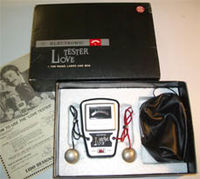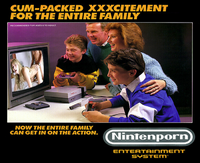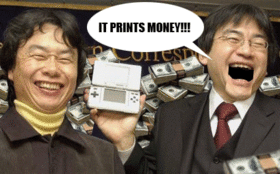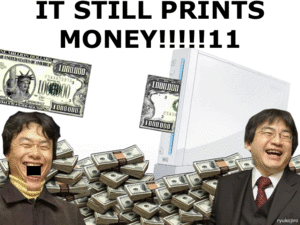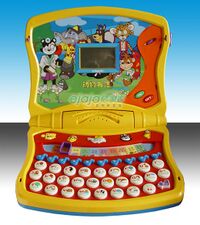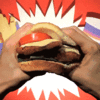Nintendo
This page contains out-of-date information or is out of date in general. Please proceed to |
 Nintendo attempts a "new and improved" method of advertising. | |
| Founded | 1889 |
|---|---|
| Founder(s) | Mario |
| Headquarters | Mushroom Kingdom |
| Key people | Shigeru Miyamoto, Reggie Fils-Aime |
| Industry | Vidja gayms |
| Owner(s) | Bowser Koopa |
Nintendo Co., Ltd. (Japanese: 任天堂株式会社 Nintendō Kabushiki Gaisha) is a Japanese electronics corporation. They are best known for producing classic video games (Mario, Zelda, Metroid, Pokemon, Donkey Kong, etc.), revolutionizing the game industry, and — more recently — producing kid-friendly shovelware with controllers that mimic deal-doughs.
Founded in 1889 by Japanese entrepreneur-cum-weekend warrior Fusajiro Yamauchi, Nintendo originally made trading cards for Japanese children to compete with American baseball cards. By 1963, they had experimented with other business ventures, such as the Nintendo Cab Company, the ill-fated Nintendo Love Hotel, and the Godzilla franchise.
By 1985, Nintendo had developed into a prosperous video gaming corporation. Making video games Japan's third most influential and honorable economy after the anime and hentai industries. It is also one of the most lucrative, with a net value of 85,000,000,000 yen (approximately $82.46 USD). Their public relations staff nicely asked us to write a story about them, and we decided to comply.
History
1889–48: Card company
Nintendo's origins can be traced all the way back to the year 1889, when Fusajiro Yamauchi was the Secretary of Entertainment for the Emperor of Japan. With the threat of civil war looming, the Emperor in all of his greatness and majesty called upon Yamauchison to create a distraction that would keep the common people's minds on more trivial matters and off-of rebelling against his Empire. Yamauchi and the Emperor effectively partnered to found the Nintendo Playing Card Company Limited.
Their first product was intended to be a win-win situation: Poketto Monsutā cards would be a worthy competitor to American baseball cards, and they would distract the people of Japan from all of the abuses the constipated Emperor was committing against them--such as the weekly reading of various religious texts in town squares, the flogging of people who yawned during the reading of various religious texts in town squares, and the execution of people who questioned the wisdom of the flogging of people who yawned during the reading of various religious texts in town squares. Naturally, the people played with their new Poketto Monsutā cards during these readings to stave off yawning, and liked them so much that they soon forgot about the abuse.
As Japan continued on its meteoric and glorious rise to prominence in the world, Poketto Monsutā continued to help Nintendo grow the company. It was said that when the Treaty of Portsmouth was signed, the Japanese gave the Russians a starter deck of Poketto Monsutā cards as a symbol of good-will following the Russo-Japanese War of 1905. This prosperity continued up until the 1940s.
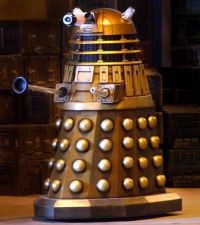
1953–56: Godzilla
For a few years in the 1950s, Nintendo created an entire product line of fire-breathing monster-themed films, wind-up toys, memorabilia, clothing, and nightclubs. Their signature symbol, a 200-foot tall lizardly-looking creature named Godzilla, battled the ignoble destruction of Japanese properties by monstrous dishonorable cowardly forces. These forces came from the sea, which is where Godzilla was supposedly "born" in the monstor's back-story.
The franchise carried Nintendo for several years, until competitors began to create their own competing lines of giant insect and huge bird monster products. The Godzilla monopoly collapsed, but Nintendo had fortunately squirreled away enough profit to fund their next venture.
1957–75: New Ventures
In 1956, Nintendo CEO Hiroshi Yamauchi went to America to get inspiration for new business ideas. It was then he realized that simply making only Pokemon cards severely limited Nintendo's business opportunities. With this in mind, he brokered a deal with Disney to give him access to their beloved characters, which he used generously to immediately boost sales. This venture was short-lived, however, due to their selected images failing to enchant the world's youth as intended. In fact Donald Duck bowing to the Emperor of Japan, and Mickey Mouse training Minnie in the ways of the Geisha, gave the non-Japanese children frequent Disney-themed nightmares.
Always a man to look forward, Yamauchi rapidly renamed his Nintendo Playing Card Limited business to Nintendo Company, UnLimited to symbolize their willingness to try anything at least once. It was also at this time that Nintendo dusted off the playbook and added a new chapter by creating arcade video games.
1975–present: Electronic era
By 1975, Nintendo started developing the product that would eventually define them : video games. Beginning with Game-and-Watch-and-Game clockwork game Nintendo also started developing its Color TV Game consoles at about the same time, along with a line of simple video games, like tennis. Around then they hired Shigeru Miyamoto, who would later take over the entire company. His rise to prominence was most evident with his creation of Donkey Kong, which features such recognizable characters as Mario, Donkey Kong, Princess Peach, and Barrel #2.
In 1980, they released the digital Game & Watch, the world's first handheld gaming system. The series was very successful worldwide, despite its "imaginary" graphics.
Nintendo also made "useful" devices like the Love Tester. Love testers, developed to help Japanese teenagers see if they were compatible, involved hooking wires up to ones genitals and applying mild electrical voltage. It usually took the average Japanese teen four or five tries to realize that the product really didn't do anything besides shock one's genitalia. Nintendo executives laughed at this, and celebrated even more as they directed complainers to Nintendo's new "no refund" policy.
Then, eureka! Real success started to pour in with the development of the new Nintendo Entertainment System, affectionately known as NES, a revolutionary product that propelled video-gaming to the esteemed place it holds today. When the NES was first marketed, it was common for kids who never played real baseball but instead played it on their TV) to be mercilessly taunted and even beaten. Nowadays kids who are fit and actually play baseball are the outcasts and objects of ridicule, and those who taunt or bully them are cheered on by their peers. All thanks to the marketing geniuses at Nintendo!
Products
NES and SNES
Since the 1980s, Nintendo has been a leading developer in the plumbing themed video game industry. Bored with the 8-bit graphics of the NES, Nintendo released the same console except with super in the title and 8 more bits. Now children could descend pipes and stamp on things with more pixels and colour depth. The 16-bit version known by the creative name of Super NES or in Japan The Super Femidom. The new console wiped the floor with all competition; the inferior Sega Genesis, and set the standard for the next few years of plumbing and monkey related entertainment.
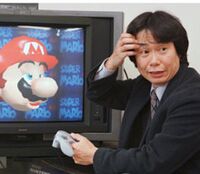
Nintendo 64
The Nintendo 64 (N64) was the first Nintendo console with the power to support 3D graphics. The 64-bit machine boasted classics such as Super Mario 64, The Legend of Zelda: Ocarina of Time, and Fly Me to the Moon on Gossamer Wings (popular with gay teens, a growing and demanding demographic). Despite its success, however, it lived in the shadow of Sony's PlayStation console, which offered better graphics, better gameplay, and CD technology to the public. Shigeru Miyamoto responded by quietly ordering the total destruction of the inferior company Sony; but alas, the Japanese press quickly uncovered Nintendo's plan and their sales dropped. However, the buyer's attention was quickly drawn away from the scandal when Nintendo released a new Mario game, sales climbed to an all-time high in the following weeks, and Nintendo executives swam in money and seasoned their food with gold dust once again.
GameCube
The GameCube was a 4-D linear-progressive game, played on a tabletop screen with paddles for three players, which let the player compete against the greatest cube masters of all-time. It had the novelty of Internet access to engage in most honorable competition on-line, a way to play just one color at a time in realistic holographic/interface.
The GameCube also contained a play-mode where once could become the cube itself, manipulating the world outside of the cube by creating a massive 54-sense jigsaw puzzle by using game-pieces made of photons and pressure points entering the cubist brain-unit in one hundred million bytes of information per second. Fun for the whole family!
Nintendo DS
The Nintendo DS was a revolutionary device that allowed the player to interact directly with the screen, much like a mobile phone; unlike the mobile phone, the Nintendo DS came with two screens for the price of one (one really expensive screen, that is). The Nintendo DS swept the video game market with just a few days after its release, to the point one could say it printed millions of dollars to the Nintendo businesspeople (pictured).
The DS has a wide-range of games carefully copied from the Nintendo 64, including classics such as Super Mario 64, Kirby 64, and Mario Kart 64; slightly renamed for the newer game system. The titles became Super Mario 64 DS, Kirby and the Magic Mirror, and Mario Kart DS respectively. N64 fans need not fear, nothing about the games was changed at all between the name changes. At the very least, Nintedo could come up with good games in the first place, more than Sony and Microsoft can say for themselves.
Nintendo Whatever It Is (Wii)
Without a doubt, Nintendo's most memorable product as of yet is the Whatever It Is. Touted as the most photo-realistic gaming system to date (neglecting to mention that the date referred to was sometime in 1996 rather than 2006); with the Wii, it was claimed, you could "golf" with Tiger Woods, "bowl" with Paris Hilton, and "interrupt" the acceptance speeches of Taylor Swift, all with just a slight movement of your wrist. Featuring unique motion controllers, the Wii was promoted as the first healthy video-gaming system, and was said to have been designed with "Americans in mind." The hype created by Nintendo prior to the release of the Wii was huge, and its health benefits were extolled worldwide (independent studies, however, later proved that the wrist movements needed to play most Wii games is about as calorie-burning intensive as tossing off a quick one).
The Wii also features the amazing Mii system, where the player is allowed to place part of their soul into a bobble-headed cartoon character after removing arms and legs. When Nintendo realized that this was self-defeating, and the limbless Mii couldn't participate in the planned 'Wii Sumo' they hastily made a game that restores the character's arms and legs, but only lets it use one of these at a time.
The Wii release anticipation was brought to a fever-pitch when it was revealed that the Emperor was personally looking forward to playing the multi-game "Wii Sports". With this title players compete in a variety of "sports," such as baseball and tennis, without having to go to the trouble of actually joining a team and experiencing social interaction. The photo-realistic quality and naturalism of Wii Sports was touted as a way for Japanese youth to feel like they were extremely good at sports, which greatly increased their self-esteem. The unintended downside of this was having their dreams crushed upon trying these sports in real life. Ultimately, though, the prospect of flicking one's wrist slightly for hours on end, without the use of a magazine, did not appeal to the youths of Japan, and therefore, the product has suffered since release. The Emperor has since declared Wii Sports to be "not at all like sumo" and sales of the game have plummeted to unthinkable and shameful levels.
Nintendo 3DS and Wii U
After the huge success of both the Nintendo DS and the Wii, Nintendo was unable to come with a better idea for a console, so they decided to sell the same products once again and expect that people wouldn't realize. Unluckily, far from reliving the same success, the Nintendo 3DS and the Wii U left Nintendo a huge whole in their wallets. But Nintendo wouldn't give up that easily, and in 2017, a new heir to the Nintendo Hall of Fame would be born...
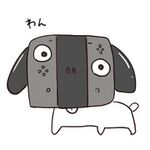
Nintendo Switch
The latest Nintendo console, the Nintendo Switch, allows the player to switch between the comfort of their home and the un-comfort of going outside, thus creating the perfect hybrid system that combines the Wii and the Nintendo DS -what the Nintendo 3DS and the Wii U Nintendidn't. After the flop that these two consoles were, the Nintendo Switch allowed Nintendo to be once again crowned as the leaders of the gaming industry.
The Nintendo Switch has been enjoying notable success since his release and still does so this very day. It features a wide range of video games and vidja games, such as "Super Mario Theft Auto", "Super Mario LSD", "The Legend of Zelda: Minecraft Edition", etc. The console also features a special gimmick, known as joy-con drift, that allows Nintendo to cash-in in the untapped market of scamming your fans and not getting sued over it.
Future of Nintendo
Many futuristic games and features are in the works over at the Nintendo building, down the block from the Emperor's palace. The Emperor is reportedly eagerly awaiting the much more interesting latest entries to the Wii Sports franchise, and monitors their progress from his windows. From documents smuggled out of Nintendo's home office (in the empty samurai sword-holders of dishonorable Sony corporate spies) it is apparent that Nintendo plans to blow the competition away with its perfectly ingenious implementation of superior motion-technology. One new game hearkens back to the simple days of Nintendo tennis. It will come with a real 2 ft. x 2 ft. (60 cm x 60 cm) blacktop on which the gamer stands, and through the ingenious use of Japanese motion technology the gamer can feel like he/she is running on gravel, clay or grass. They can even flirt with the simulated ballgirls/ballboys, all with the flick of a wrist. Nintendo has prophetically named the game "Blow the Competition Away".
Another product near completion (in the spirit of Nintendo's historical need to expand into multiple industries) is a deluxe portable silicon-based robotic dog which pees, attacks strangers, licks various body parts of the owner, and humps the legs of all worthy citizens. The dog is programmed to chase squirrels all the way up a tree and into their little nests before tearing them apart. You'll be the envy of your neighbors!
There is also a game in development in which a player rushes into a Tokyo building as it catches on fire. The main character (either the honorable fireman or the beautiful heroine) must rush through the falling rafters, melting steel, and hidden arsonists to save the baby and the princess trapped in the inferno. (Increased difficulty adds realism to the arsonists attempts to either stop the rescuers or to push them into the flames.) The funny plot-twist? When the player gets to the end they are given a choice of saving either the baby or the princess, but not both! Interestingly, when loyal subjects tested this game, it seems that the choice of who to save was almost always predetermined by the gender of the person playing. Such are the ways of:
